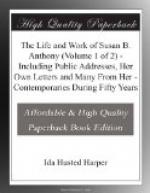[Illustration:
Temporary home of the
Anthonys, Battenville, N.Y., 1826
From A photograph taken
in 1897. Susan and Merritt
in foreground.]
But the battle had to be fought continually. A saw-mill and a grist-mill were built and no man was employed who drank to excess. The tavern keeper, who had expected to reap a rich harvest from the factory, was very indignant at the temperance regulations. He put every temptation in the way of the mill-hands, but Daniel Anthony remained firm. Among his papers are found several letters of repentance and pledges from his men who had fallen from grace and wanted another trial. He organized a temperance society, composed almost entirely of his men and women employes. The pledge, as was the custom, required “total abstinence from distilled liquor,” but allowed wine and cider. He also established an evening school for them, many never having had any chance for an education, and it became unpopular not to attend. This was in session also a few hours on Sunday. It was taught by Mr. Anthony himself or his own family teacher without expense to the pupils. Everything about the factory was conducted with perfect system and order. Each man had a little garden around his house. Mr. Anthony looked upon his employes as his family and their mental and moral culture as a duty. Even thus early he was so strong an opponent of slavery that he made every effort to get cotton for his mills which was not produced by slave labor.
The only persons ever allowed to smoke or drink intoxicants in the Anthony home were Quaker preachers. The house was half-way between Danby, Vt., and Easton, N.Y., where the Quarterly Meetings were held and the preachers and elders stopped there on their way. In a closet under the stairs were a case of clay pipes, a paper of tobacco and demijohns of excellent gin and brandy, from which the “high seat” brothers were permitted to help themselves. It is not surprising to find in the annals that a dozen or more would drop in to get one of Mrs. Anthony’s good dinners and the refreshments above mentioned.
In the spring of 1832 a brick-kiln was burned in preparation for the new house. Mrs. Anthony boarded ten or twelve brick-makers and some of the factory hands, with no help but that of her daughters Guelma, Susan and Hannah, aged fourteen, twelve and ten. When the new baby came, these three little girls did all the work, cooking the food and carrying it four or five steps up from the kitchen to the mother’s room to let her see if it were nicely prepared and if the dinner-pails for the men were properly packed.




